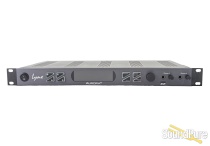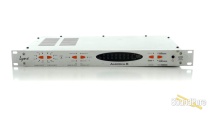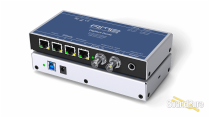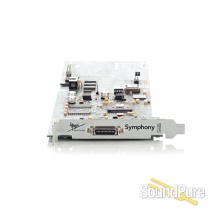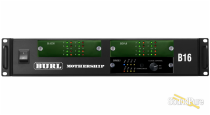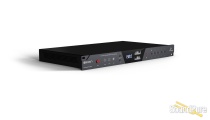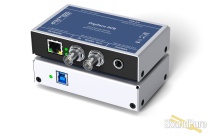-
Call Us Toll Free888-528-9703
-
Local/International (+1)919-682-5552
- Call Us! Toll Free! 888-528-9703
- Local / International (+1) 919-682-5552

Universal Audio Apollo 16 Thunderbolt 2 Interface - Used From UA
UA's flagship 16 x 16 converter with UAD-DSP processing just got even better - next generation conversion technology, lightning-fast Thunderbolt 2 connectivity, and advanced daisy-chaining capabilities secure the Apollo 16 as one of the industry's top converter systems. In Used, Excellent Condition
"Gone, Baby, Gone"
This one is sold. Don't miss the next one. Some things never even make it to the site so stay up to date on our used collection.
We get in many oddities, rare and vintage products, most of which go fast. If you're on the hunt for something specific, something unique, or something priced right, let us notify you on our used collection before the items even hit the site.
Want to know if one lands?
Notify MeWant to discuss what's coming?
Manufacturer's Description from UA
Apollo 16. Flagship Apollo Conversion for Professional Studios.
Key Features
- Next-generation Apollo A/D and D/A conversion for professional music production
- 16 x 16 analog I/O via DB-25 connectors — ideal for pairing with mixing consoles, outboard preamps, etc.
- Onboard UAD-2 QUAD Core DSP allows Realtime UAD Processing
- 18 x 20 Thunderbolt 2 audio interface for Mac with powerful Console 2.0 software control
- Cascade up to 4 Apollo interfaces and 6 UAD devices total over Thunderbolt (Mac)
- Includes “Realtime Analog Classics Plus” UAD plug-in bundle
- World class UA analog design, superior components, and premium build quality
World-Class Sound with Superior Apollo A/D and D/A Conversion
The original Apollo, introduced in 2012, quickly became a gold standard among modern music producers and engineers — it now counts many of the world’s top artists as users. Apollo 16 improves upon the original Apollo’s sound quality with completely redesigned, class-leading A/D and D/A conversion — giving you increased dynamic range and even lower THD. Building upon a 50-year legacy of circuit design, UA engineers started with obsessive auditioning of the latest converters, pairing them with completely redesigned analog circuitry. Confirmed by extensive double-blind listening tests, the result is 2 dB better A/D and 8 dB better D/A dynamic range versus the original Apollo — making Apollo 16 the measurable class leader.
Realtime UAD Plug-In Processing for Tracking, Mixing, and Mastering
Imagine having a classic analog studio, in single rack space. Apollo 16 lets you record through UAD Powered Plug-Ins — including vintage EQs, compressors, reverbs, tape machines and more — at near-zero latency, regardless of your audio software buffer size. With award-winning UAD plug-ins from Ampex, Lexicon, Neve, Manley, Roland, SSL, Studer, and more,* Apollo 16 serves up authentic analog tone and warmth.
The key to its analog sound is onboard UAD-2 QUAD DSP Processing, which powers the UAD plug-ins while reducing the strain on your host computer.
Apollo 16 comes bundled with “Realtime Analog Classics Plus” suite of UAD plug-ins. From there, you can choose from a vast and expanding collection of plug-ins in the UA Online Store.
Improved Monitoring and Workflow
Unique among 16 channel converters, Apollo 16 features a dedicated Monitor knob right on the front panel. This knob is also controllable from software, a connected Apollo Twin, or can be bypassed for connecting the Monitor outputs to an external monitor controller. Standard interface settings like Clock Source, Sample Rate, and Host connectivity are displayed at all times as well.
Expand Your System
Thanks to Apollo Expanded software, users of Thunderbolt-equipped Apollo Twin, Apollo 8, Apollo 8p, and Apollo 16 audio interfaces can combine up to four Apollos and six total UAD-2 devices — adding I/O and DSP as your studio grows. Apollo Expanded also provides seamless integration with previous generation Apollos over Thunderbolt.

About Manufacturer
Universal Audio Inc. was re-founded in 1999 by Bill's sons, James Putnam and Bill Putnam Jr., with two main goals: to faithfully reproduce classic analog recording equipment in the tradition of their father, and to design new digital recording tools with the sound and spirit of vintage analog technology. However, as Bill Jr. recounts, the genesis of "UA, part 2" is actually a bit more serendipitous.
Having grown up in the music industry, Bill Jr. and James ("Jim") Putnam naturally assumed that the music business is where they'd eventually end up. Jim, a touring musician and recording engineer, and their older brother Scott, a studio designer in Southern California, were the first to follow in Bill Sr.'s path. However, Bill Jr. took a more circuitous direction, working for a number of engineering companies before undertaking a doctorate in Electrical Engineering at Stanford University. It was at Stanford that Bill Jr. became closely involved in the Center for Computer Research in Music and Acoustics (CCRMA), specializing in signal processing. It was also at Stanford that Bill Jr. began to assemble a team of the best and brightest minds in the field — who continue to steer many of Universal Audio's engineering efforts to this day.
However, the precise event that led Bill and Jim to start (or "reinvent") Universal Audio in 1999 was unexpected. As Bill Jr. tells it, when Bill Sr. passed away in 1989, he and Jim were faced with the Herculean task of cleaning out their dad's workshop and storage areas. While going through Bill Sr.'s old test equipment, boxes of parts, bits and pieces of consoles, and half-cannibalized 1176 compressors, Jim came across their father’s old design notebook. The two spent the evening poring over his notes, realizing that this was the map to every technical problem their father had ever solved. It was at that moment that they decided to bring back Universal Audio and its classic products.
Fast forward a decade. Now with nearly 80 employees and legions of new customers worldwide, UA is headquartered near the Silicon Valley, in Scotts Valley, California — where our classic analog gear is still hand-built, one unit at a time. The lengths we go to deliver the exact sound and performance of classic analog audio gear is unparalleled; in fact, the goal is for UA's modern units to perform identically to well-maintained units built decades ago.
Of course, analog is only half the story. At Universal Audio, we employ the world's brightest DSP engineers and digital modeling authorities to develop our award-winning UAD Powered Plug-Ins platform, featuring the most authentic analog emulation plug-ins in the industry. Our DSP gurus work with the original hardware manufacturers — using their exact schematics, golden units, and experienced ears — to give UAD plug-ins warmth and harmonics in all the right places, just like analog.
Specifications
System
- I/O Complement
- Analog Line Inputs 16
- Analog Line Outputs 16 (not including monitor outputs)
- Analog Monitor Outputs Two (one stereo pair)
- AES/EBU Two (Thunderbolt 1 compatible)
- Thunderbolt 2 ports Two (Thunderbolt 1 compatible)
- Word Clock One input, one output
- A/D – D/A Conversion
- Supported Sample Rates (kHz) 44.1, 48, 88.2, 96, 176.4, 192
- Bit Depth Per Sample 24
- Simultaneous A/D conversion 16 channels
- Simultaneous D/A conversion 18 channels
- Analog Round-Trip Latency 1.1 milliseconds @ 96 kHz sample rate
- Analog Round-Trip Latency with four serial UAD-2 plug-ins via Console application 1.1 milliseconds @ 96 kHz sample rate
Analog I/O
- Frequency Response 20 Hz – 20 kHz, ±0.1 dB
- Line Inputs 1 – 16
- Connector Type Two Female DB25, Tascam wiring
- Dynamic Range 119 dB (A–weighting)
- Signal-to-Noise Ratio 119 dB (A–weighting)
- Total Harmonic Distortion + Noise –112.5 dB @ -1 dBFS
- Common-Mode Rejection Ratio (CMRR) 75 dB (10’ cable)
- Input Impedance 10K Ohms
- Input Reference Level +4 dBu (fixed)
- Maximum Input Level (+4 dBu setting) +20.2 dBu
- Maximum Input Level (-10 dBV setting) +6.2 dBV (unbalanced)
- Line Outputs 1 – 16
- Connector TypeTwo Female DB25, Tascam wiring
- Dynamic Range 126 dB (A–weighting)
- Signal-to-Noise Ratio 126 dB (A–weighting)
- Total Harmonic Distortion + Noise –118 dBFS @ -1 dBFS
- Stereo Level Balance ±0.01 dB
- Output Impedance 100 Ohms
- Maximum Output Level +20.2 dBu
- Monitor Outputs 1 – 2
- Connector Type XLR Male
- Dynamic Range 124 dB (A–weighting)
- Signal-to-Noise Ratio 123 dB (A–weighting)
- Total Harmonic Distortion + Noise –117 dBFS
- Stereo Level Balance ±0.01 dB
- Output Impedance 100 Ohms
- Maximum Output Level +20.2 dBu
Digital I/O
- AES/EBU
- Connector Type XLR
- Format IEC 60958 Type I
- MADI (Not Implemented)
- Connector Type Dual Optical SC-Plug (ISO/IEC 9314-3)
- Word Clock
- Connector Type BNC
- Lock Range ±0.5% of any supported sample rate
- Word Clock Input Termination 75 Ohms, switchable
- Synchronization Sources
- Internal, Word Clock, AES/EBU
Electrical
- Power Supplies External AC to DC Power Supply, Level V compliant
- AC Input Connector Type IEC Male
- AC Requirements 100V – 240V AC, 50 – 60 Hz
- DC Connector Type XLR 4-Pin Locking Male (Neutrik P/N NC4MDM3-H)
- DC Requirements 12 VDC, ±5%
- Maximum Power Consumption 50 Watts
Mechanical
- Dimensions
- Width 19”
- Height 1.75” (1U rack space)
- Depth, Chassis Only 12.125”
- Depth, Including Knob & Jack Protrusions 13.5”
- Shipping Box (Width x Depth x Height) 24” x 17” x 8”
- Weight
- Shipping Weight (with box & accessories) 18 pounds
- Weight (bare unit) 8.7 pounds
- Package Contents
- Apollo 16 mkII Audio Interface Unit
- External Power Supply
- AC Power Cable (IEC)
- Getting Started URL Card
- Set of (4) Rack-Mount Screws





